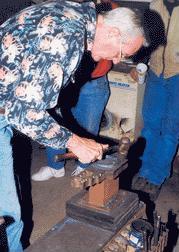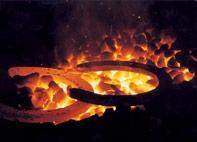Some of the most important work a farrier does takes place at least a few feet from the horse that's being shod.
Skills at the anvil can set a farrier apart from run-of-the-mill shoers. The ability to hand forge specialty shoes or fine-tune keg shoes can greatly enhance your ability to increase your shoeing incomes.
Here are some of the best forging tips that American Farrier Journal editors have gathered in recent months from some of your fellow farriers.
General Forging
1. Break the shoe-making process into steps or tasks.
- Chris Gregory, Lamar, Mo.
Danny Ward
2. People have a tendency to overwork keg shoes. We've got the hammer, we've got the anvil and we've got to him 'em. Once you've overworked a shoe, it's three or four times harder to get it back where you want it.
- Danny Ward, Martinsville, Va.
3. Learn how to make a bar shoe and how to make a clip before you start using ready-made keg shoes with these features. You need to know how to make these shoes first.
- Bob Schantz, Foristell, Mo.
4. Once you learn the basics of shoe making, it's much easier to make modifications. Making the shoes makes you learn the shapes that you are going to need and helps you get to where you can bang it into the shape you need on the first or second try. That's where a lot of people lose their time, in trips back and forth to the anvil.
- Neal Poort, Sedalia, Mo.
5. I used to make shoes wider because then they were easier to modify at the shoeing site. But I found it was harder to see the foot that way. Now I make them tighter and find I'm actually making fewer trips to the anvil.
- Myron McLane, Somerset, Mass.
6. Forging is the essence of horseshoeing. If you can't do this effectively, you can't balance horses.
- Richard Duggan, Ramsey, Minn.
Choosing, Using Hammers
7. The heaviest hammer that you can easily swing will do the most work at the anvil for you.
- Bob Schantz
8. Use light blows for hot work. Just kind of let the hammer drop on the shoe.
- Danny Ward
9. Use the round side of the hammer for punching. It will always drive the punch straight, unlike the round side.
10. The hammer handle should be an ideal length that suits you and won't cause pain in your arms and shoulders. Let the hammer do the work and keep your grip loose.
- Gordon Haight, Eagle Point, Ore.
Shaping Keg Shoes
11. Stay away from the toe. Think of the center of the toe as being at the 12 o'clock position and center your hammer blows at 11 o'clock and 1 o'clock to move the branches.
12. To change the curve of the shoe, focus your hammer blows on the center. Don't continue down to the end of the branches.
13. Check the width as you go, particularly if you're a novice. It's easier to get the branches to bend in than it is to bend them back out.
14. Don't "chase" the shoe while working at the anvil. Pick a spot close to the anvil to strike and use the tongs to roll or rotate the shoe through that spot, toward the anvil.
15. If you strike a shoe on one side, strike it an equal number of time on the other side, if the hoof is uniform.
- Danny Ward
Leveling The Shoe
16. In leveling a shoe, work along the inside branch of the shoe with a flat side of the hammer.
17. Keep as much of the shoe flat on the anvil as possible.
- Danny Ward
Creasing Shoes
18. Don't let the creasers flop over when they are hit. Hold your creasers square.
- Gordon Haight
Nail Holes
19. Don't overdo punching nail holes. You don't want the nail to have too much play. Keep the taper straight. Place a nail in the hole to check the fit, paying particular attention to the nail head.
20. Clean out nail holes with a pritchel, working from the ground side since the holes in the shoe and pritchel are both tapered to match in that direction.
21. Chipping a little piece of iron out of the first two nail holes will make it easier to fit the shoe accurately.
- Danny Ward
22. Rotate the shoe so it is square to the punch that you are using.
23. Develop a rhythm by noting how many hits it takes to come up with the nail hole that you want.
- Gordon Haight
24. By resting the forepunch in the shoe before actually punching it, it's going to suck up all that heat and upset. It'll mess up the punch and your hole sizes, so stay off the material. Hang the forepunch over the shoe and rest it on the hammer. When you see what you want to punch, set it quickly, make three blows with the hammer and get out of there.
- Roy Bloom, Drummond, Wis.
25. Don't let the punch stay in the hole any longer than it takes to make an impression of the nail head. With the right punches used at the right temperatures, it should take only three hammer blows to do the job.
26. Trying to pritchel the shoe when it is too hot will cause the metal to stretch instead of shear or cut. When this happens, the little piece will remain attached to the shoe and can cause problems.
- Chris Gregory
27. If nail holes in a keg shoe are too tight, open them up slightly with a 5/32-inch drill press bit.
- Bob Skradzio, Ambler, Pa.
Using Aluminum
28. Only build one shoe at a time since you can't leave one shoe in the fire while the other is being worked.
29. Make sure your anvil is clean of slag and rust prior to forging aluminum. Foreign objects are easily hammered into aluminum stock since it is so soft.
- Chris Gregory
30. If you heat aluminum in the fire, don't take your tongs off the material. It heats up real fast and you want to be able to get it out of the fire quickly.
- Bob Schantz
Drawing Clips
31. Level a clip by holding the clip closest to you on the anvil.
- Bob Schantz
General Safety
32. Wear safety glasses and noise suppressors when forging.
- Monica Hoff, Green Bay, Wis.










Post a comment
Report Abusive Comment